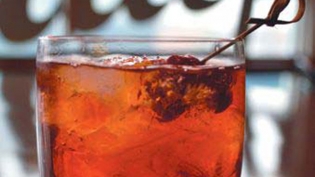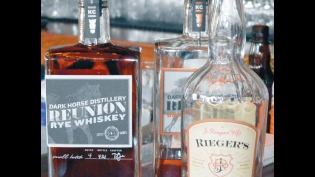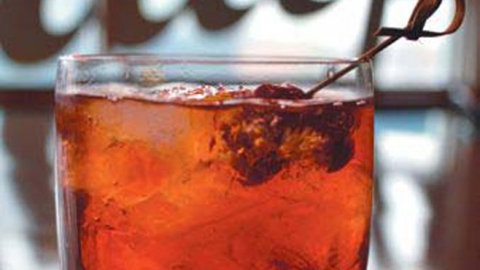Whiskey: The Water of Life
Like a repentant sinner at an old fashioned Pentecostal camp meeting on a humid summer afternoon in the Ozarks, whiskey is experiencing a genuine revival. A lenthening line of brave souls are taking the plunge and launching their own distilleries. An expanding priory of whiskey-centric bar owners and mixologists are preaching the true faith of distilled corn and rye. A growing congregation of enthusiasts are discovering that their hearts are strangely warmed by a growing choir of varieties. It’s called the water of life. The water is sweet and the life is good in Missouri these days for whiskey lovers.
First of all, a primer. At its most basic, whiskey is corn, rye, wheat or barley - or some combination thereof - turned into a mash, fermented, distilled and generally aged in wood casks into a strong, tasty spirit. Things get a lot more complicated from there.
The strict rules and standards governing the production and bottling of the different varieties could have been concocted by a Borges character. Canadian whisky, for instance, is required to be aged in 700-liter wood barrels for at least three years, contain no more than 9.09 percent imported spirits and taste like Canadian whisky. It’s pleasing to think there is a very happy soul who is paid to taste test Canadian whisky for its Canadian-ness. There are similarly Biblical prescriptions ruling Bourbon, rye, wheat, corn, straight, bent, Scotch and the dozen or so other types of whiskey.
“Bent” isn’t really a whiskey, but it is how you’ll make whiskey purists feel if you drop ice in your glass. Do it only in secret while reading the articles in Playboy. All this is further complicated by the fact that we’ve managed to disagree yet again with our beloved cousins across the pond on word spelling. The English, Scots and most of the rest of the world spell it “whisky.” We and our sensible Irish brethren have opted to stick an F-you “e” in the word, because we can.
The word whiskey actually derives from an unpronounceable Gaelic word meaning “water of life.” The Celts used their grain to make a lot of beer, but even that wasn’t enough. Over time, they developed stronger spirits, the type that really made the difference during those long winters and multi-generational clan wars. This helps explain why Celtic myths are so damn entertaining. Whiskey is the real reason the Irish saved civilization. (I’m not sure that’s a true fact, so don’t use it for your doctoral thesis.)
So, there are a lot of whiskeys made in many different ways and tasting of many flavors. Don’t sweat all that homework. Instead, visit a local spot that stocks a decent supply and employs an expert, and let them walk you through it a taste at a time. One such maestro is Dylan Vandyne, a charming and erudite member of the charming and erudite staff at the Cellar & Loft in Kansas City’s River Market neighborhood. This establishment is best known as a top-flight though unpretentious wine club. Fewer people are aware that it also sports a stellar selection of spirits, including some 130 varieties of whiskey on average, according to Vandyne.
Visitors enter a spacious woodlined main room - the “Loft” - then cross to Valhalla by descending into an appropriately rustic and dim cellar lined with adult beverages and populated with comfortable furniture tucked into intimate nooks. In other words, it’s perfect.
One of the best ways for a novice to begin to explore whiskeys is to use your nose first, Vandyne explains. “Cup your hand over the top of an open bottle of whiskey, rub your hands together, then bring them to your nose,” he says. “You’ll really get the essence of the whiskey. You’ll be able to pick out the tasting notes: vanilla, chocolate, smoke - whatever is distinctive about that brand.”
Vandyne confirms that there has been a whiskey revival across the Kansas City region and the U.S. He and other experts see it as part of an evolution of the craft beer movement. “A lot of folks who were enjoying craft beer in their 20s and 30s are now maturing and want a more mature drink,” Vandyne says. “Whiskey is filling that need. I think it’s an evolution for the palate and the mind.”
Beau Williams opened the whiskey-centric Julep Cocktail Club in KC’s Westport neighborhood in April 2014. He agrees that whiskey is back. Drinkers are discovering or rediscovering the pleasures of slow-sipping a whiskey neat and the seemingly endless ways that it can be mixed.
“They want those robust, complex flavors,” Williams says. “Every whiskey is a little bit different, so you can’t get bored. A classic cocktail that you know well, like a Manhattan, can go in a whole different direction by switching up your whiskey.” Julep coyly hides its cosmopolitan wonders behind a simple door. Inside, an enormous wall of spirits is backdrop to a long bar ably staffed by some of the best mixologists in Kansas City. For a whiskey lover, the experience is like taking communion in St. Paul’s Cathedral.
The locavore movement has also played a part in the whiskey revival, according to Williams. Whiskey has a long, distinguished history of local production. It lends itself to small batch crafting, he says. A locally distilled whiskey pairs perfectly with your locally sourced steak and cheese.
Missouri is not foreign to neighbors making their own spirits. Moonshine - an unaged variety of whiskey - is practically a folk art in some parts of the state. And, the state has a worldwide reputation for being home to the white oak casks in which most whiskey is aged. Some of the best and most expensive single malt Scotches spend quality time in wood grown and barrels built in southern Missouri.
But now a growing number of local distillers are starting to produce high quality and legal whiskeys that are garnering posi attention. That includes Weston’s McCormick Distilling - which, in fairness, comes from a whiskey pedigree that stretches back to the 1850s - maker of Triple Crown Bourbon; Ozark Distillery in Osage Beach, maker of a fine, warm Bourbon; and Of the Earth Farm, maker of Ray County Rye, a personal favorite of Vandyne. “These are really great beverages, period,” Vandyne says.
Mike Anderson is owner of Mid-Best Distillery in Gravois Mills, Mo. They were an early entry in the whiskey revival. He cites a shift in state law just a few years ago as a major factor in whiskey’s trending popularity. “The law was changed so that you could make up to 200 gallons without having to get a license and permits or pay taxes,” he says. “People started to make their own and it spread from there.”
Anderson didn’t actually intend to become a distiller. He and his partners originally wanted to make their own fuel, but soon realized they’d rather drink their product than send it down a gas tank. They now sell dark and white rums, a wheat whiskey, and a moonshine. A rye whiskey and five more flavors of moonshine are slated for release by next summer.
Small distillers use small barrels, which means more of the whiskey comes in contact with the scorched wood compared to the large barrels used by large operations, according to Anderson. He thinks that the emphasis on small batches, plus carefully hand selected ingredients, and the individual tastes of craft distillers make all the difference.
“You’d be surprised at how smooth these small batch whiskeys taste. Small distillers are putting out a much higher quality product at a comparable price to the major producers, so you get more bang for your buck,” he says. “People are seeking out the mom and pop operations that make a better product.”
In Kansas City, Dark Horse Distillery has already gathered a loyal band of followers. Its Bourbon and rye have garnered multiple honors, including a 2014 bronze from medal from Whisky Magazine’s World Whisky Awards.
Most recently, Ryan Maybee has turned his attention from helping launch and foster the Rieger Hotel restaurant and Manifesto speakeasy to relaunching the Rieger distillery in a refurbished building in the still raw, simmering East Bottoms neighborhood. As Maybee explains in a January 2011 blog post, Rieger was one of the nations largest whiskey producers and distributors from the late 19th century until Prohibition in 1919. He was inspired to revive the label after learning about Rieger’s significant though obscure history.
New distillers, whiskey-centric bars and a growing congregation: all of this is good news for the Cowtown faithful. “It’s an exciting time to be in the whiskey business in Kansas City,” Williams says. “A lot of these distillers still need more time to age their product and perfect their craft, but I’m looking forward to tasting the results of their work.”












